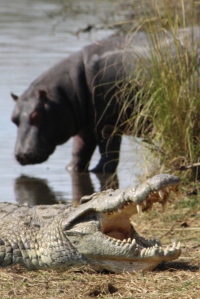I recently spent a few days in the African bush. One of the pleasures of having a base in Johannesburg is easy access to the Kruger National Park. KNP is a beautiful natural environment larger than the entire country Israel.
One of our drives out into the wild led to a bird hide on the bank of the Sabie river. The sightings at the bird hide got me thinking about ecology and the ecology of the workplace. A bird hide allows people to sit quietly and unobserved while they watch animals in a natural environment. Through a long horizontal slit in the side of the structure we could watch the activity in this natural lake. It took some time to take in all that was visible.
Over the next few posts I will play with the idea of corporate “animals” that we encounter regularly. This is also an opportunity for me to put up a few of my photographs! Maybe you can recognise some of your colleagues over the next few posts. Who are the hippos, the herons, the kingfishers, elephants, zebra, and of course the endearing warthogs?
But let’s start with the crocodile. On the small sunny sand bank there was an old crocodile lying motionless. Around him there were many different types of birds. I’m not much of a birder, so I’m not able to list all the species. By the excited oo’s and aah’s that came from the two older women who were flicking through their bird books – all the while moving excitedly between reading glasses and binoculars – there were quite a few rare sightings. Old mr crocodile really didn’t seem to care about any of this. He may as well have been dead.
At one point one of the hippos who had been wallowing in the shallow water made his way onto the sand bank and almost stepped on the sleeping mr croc. Mr croc really just lay there looking ferocious.
A while later he opened his mouth in an impressively slow and lazy way. There is a myth that crocodiles sleep with their mouths open so that birds will come to clean their teeth. I didn’t see that happening, but he looked like he was waiting for some edible morsel to jump into his mouth.
The croc has an uncanny capacity to survive. No matter what has happened on this planet since prehistoric times crocs remain – they have been on this planet since the dinosaurs. The corporate crocodile might have made it through restructures, mergers and new managers without needing to move. Crocs know the ropes. Minimal energy expenditure for maximum result.
As a manager you might be on the verge of taking action to manage their performance and find yourself surprised at their sudden level of impressive activity. Crocs can laze around for four months without eating and then suddenly turn into fast ferocious killing machines.
Crocs know how to stay comfortable. They regulate their body temperature by staying close to the water so that they can cool down easily. In the same way your corporate croc will never be found far from the coffee machine or break room for long. If someone is complaining about the quality of the office chairs, you can bet it’s the office croc.
You may have heard the term crocodile tears. Of course crocodiles don’t really cry. Their eyes produce liquid when their jaws are busy munching on their prey. The corporate croc shows extreme remorse when confronted about their performance or lack there of. Apologies and long faces will mask the croc’s true understanding of the situation.
Crocs can move about incredibly silently. Hippo’s make a lot of noise and the corporate hippo is full of complaints, but the corporate croc is the silent, but slow type. Not very verbose, but also not very productive. Because they don’t draw a lot of attention by making noises, they can be ignored for long periods of time.
Managing a croc:
- The sense of safety and being in a comfort zone is important to your croc. They are happy to hide and underperform. Challenge the croc with new goals and activities and monitor them with awareness.
- Don’t be manipulated by crocodile tears. A true croc has it figured out and will appear to be the victim while devouring your attempts at management. Be firm and clear about your expectations. Show empathy, but don’t be manipulated.
- Don’t be fooled by passivity. Even though they seem incredibly passive, they are ferocious predators. Set high, but realistic expectations for their performance. The challenge here is to understand that they can and do perform if they want to. You need work on their willingness!
- Get them on your side. Crocs are the most caring of reptilian parents. (Crocodiles are known to care for their young long after they have hatched.) Get your croc to feel that they need to care for the company values and for you. Even though crocs are masters at appearing like they don’t care, having a croc on your side can be an wonderful asset.
- Look out for my post about the kingfisher next!
I would love to hear about the animals in your office 🙂 … Leave a comment or send me a mail!





[…] The corporate animal – 1 – mr/ms croc August 7, 2013 […]